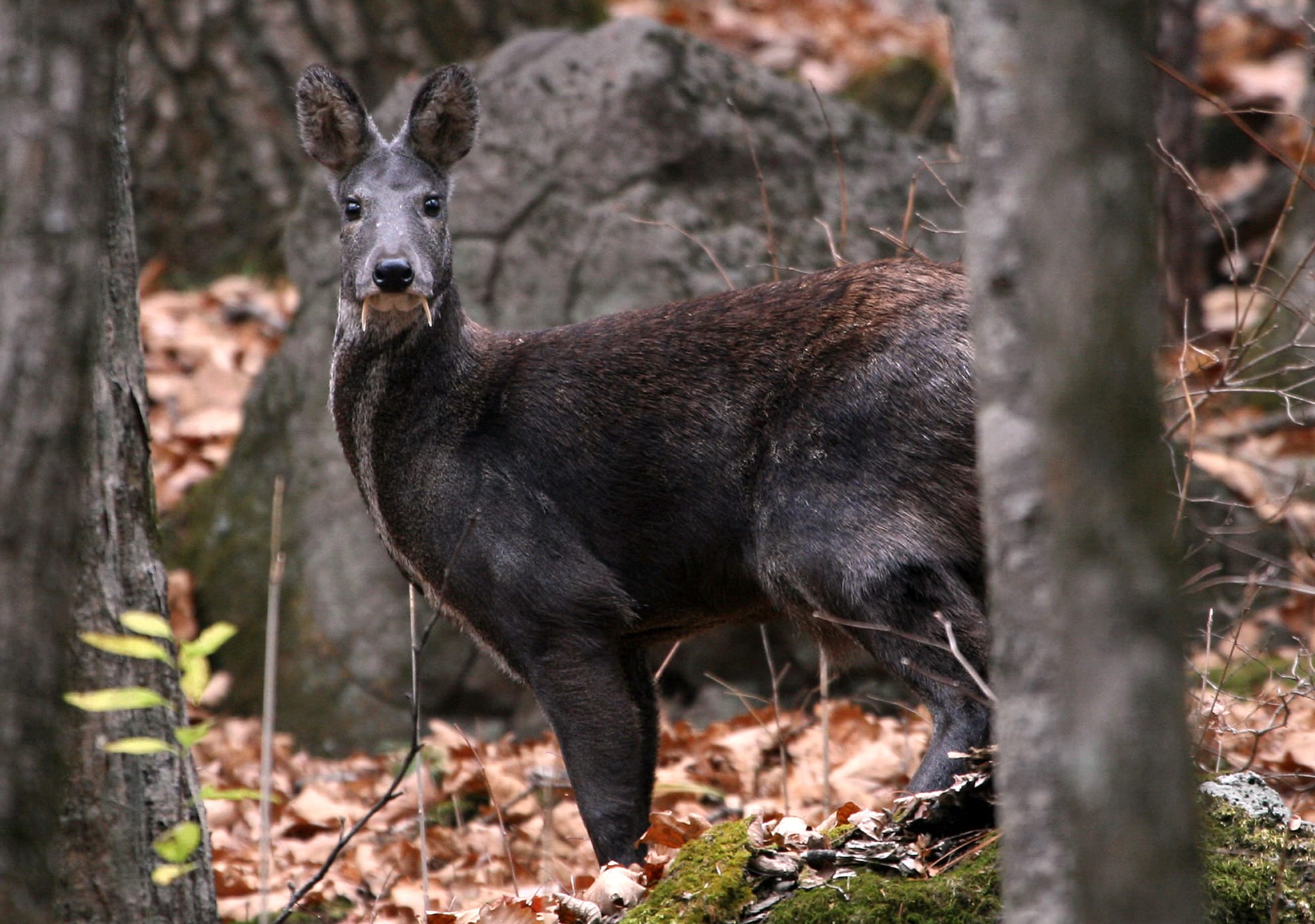Prepare to be amazed as we explore the captivating world of deer with fangs, creatures far from the menacing image their nickname, “vampire deer,” suggests. These elusive animals have an intriguing story to tell, and we’re here to unravel the mystery behind their prominent fangs. From their fascinating mating rituals to their role in the delicate dance of nature, get ready to discover the captivating story of these extraordinary animals.
Why Do Some Deer Have Fangs?
Okay, let’s be real, the phrase “deer with fangs” sounds like something straight out of a fantasy novel. But guess what? They’re totally real! These fascinating creatures, while sporting some impressive dental work, aren’t lurking in the shadows waiting to suck your blood. So, what’s the deal with those fangs?
Firstly, let’s get the terminology straight. Those pointy things in their mouths aren’t technically fangs; they’re actually elongated canine teeth called tusks. And instead of being used for spooky vampire business, these tusks are primarily tools for, well, boys being boys.
Think of it like this: imagine a group of guys trying to impress the same girl. Some might flex their muscles, others might try to show off their smarts, and some might even resort to, let’s say, a bit of chest-puffing. Well, male musk deer and water deer – the only two deer species rocking these impressive tusks – use them in a similar way. Their tusks are their way of showing off during mating season, establishing dominance, and saying, “Hey ladies, look at these pearly whites! I’m the buck for you!”
Now, you might be wondering, “Why did these deer keep their tusks while other deer evolved to have antlers?” Great question! Scientists are still trying to figure out all the specifics, but it probably has something to do with their environment and lifestyle. Imagine a dense forest where antlers could get easily tangled – not exactly ideal for a quick getaway. In these environments, tusks might be a more practical tool for both defense and settling disputes.
What are “Fanged Deer” Called?
So you know how some people call those deer with fangs “vampire deer?” Well, that’s not quite right, but it’s understandable why they’d think that! The truth is, these fascinating creatures are actually two different types of deer: musk deer and water deer. Both of these guys sport some pretty impressive canine teeth that stick out like fangs, making them look a bit like little vampires of the forest.
Musk deer, found wandering the forests of Asia, are probably best known for their unique aroma. They produce a strong-smelling musk used in perfumes – bet you didn’t expect that! On the other hand, water deer, true to their name, are known for their swimming skills and call the watery regions of China and Korea home.
Both kinds of fanged deer are relatively small and not considered dangerous to humans. They’re more likely to use those fangs to impress each other than to threaten us. So while “vampire deer” might be a catchy nickname, it’s just not accurate. Musk deer and water deer are simply unique and intriguing animals that deserve our admiration, fangs and all.
Why Do Deer Have Fangs Instead of Antlers?
So, you’ve heard about deer with fangs? It sounds like something straight out of a fantasy movie, right? Well, the truth is, these “vampire deer,” as some people playfully call them, are far from bloodthirsty monsters. They’re actually peaceful plant-eaters, and those curious fangs? They’re not for sipping on blood but rather tools passed down through generations for survival.
Think of it this way: those fangs are like ancient family heirlooms. Way back in time, their ancestors didn’t have the large antlers that many deer sport today. Instead, they relied on sharp fangs, especially the males, to duke it out for territory and mates. As time marched on, antlers developed in many deer species, likely as an adaptation to different environments and fighting styles. But here’s the interesting thing: some deer species held onto those fangs.
Scientists believe that tusks offer unique advantages in certain places. Imagine dense forests where bulky antlers could get snagged on branches – fangs, being more compact, would give those deer an edge in a scuffle.
So, while both fangs and antlers help with competition and attracting mates, their effectiveness might depend on the surroundings. It’s a classic case of evolution finding different solutions for success!
Now, you might be wondering how those fangs actually come into play. Well, picture this: it’s mating season, and two male deer lock eyes, their antlers (if they have them) held high. Tensions rise, and suddenly, they charge! If it’s a fang-fight, those sharp teeth become weapons, each deer trying to land a blow and prove their dominance. It’s nature’s way of determining who’s boss and who gets the girl!
Can Whitetail Deer Have Fangs?
So, you’ve heard whispers of whitetail deer sporting fangs, like something out of a mythical tale? It’s true, but hold your horses before picturing Dracula in antlers. These aren’t quite the fangs you might imagine.
While we typically associate fangs with predators, these deer aren’t about to start sucking blood. They’re actually just unusually long canine teeth. Think of them as overachieving canines rather than true fangs. Now, how rare are these dental wonders? Well, you’d be lucky to spot one in the wild.
Experts believe that somewhere between 1 in 10,000 to 20,000 whitetail deer have these elongated canines. That’s like finding a four-leaf clover, but even rarer! And even when they do exist, they’re often small and tucked away, making them easy to miss.
Interestingly, it seems that location might play a role in this phenomenon. Some states, like Wisconsin, have yet to record a single case of a deer with these elongated canines. Meanwhile, down in Florida, a small study found them in a surprising 4.2% of the deer examined. Why this difference exists remains a bit of a head-scratcher for researchers.
Theories abound as to why some deer have these unusual teeth. Some scientists speculate that it’s a throwback to their ancestors, a blast from the evolutionary past. Others suggest it might be a genetic mutation, a quirk in their DNA. The truth is, we don’t have a definitive answer yet.
The mystery of the “fanged” deer is a great example of how much we still don’t know about the natural world. It’s a reminder that even in our own backyards, there are discoveries waiting to be made. So, keep your eyes peeled and your camera ready – you never know what you might find!
Sadly, just like many unique animals, musk deer are currently facing some serious threats due to habitat loss and, unfortunately, people hunting them for their musk. Water deer are doing a bit better population-wise, but they’re still vulnerable because of habitat destruction. So, there you have it, the mystery of deer with fangs, demystified! They might not be mythical beasts but captivating reminders of how diverse and fascinating the natural world truly is.
More Curious Creatures of the Deep
Speaking of fascinating creatures, have you ever heard of the deep-sea wolf eel? These mysterious creatures, nicknamed “dragons of the deep,” are just as intriguing as their fanged deer counterparts. Or perhaps you’d be interested in learning about animals with unique genetic conditions, like the Down syndrome giraffe or the majestic Down syndrome lion? The animal kingdom is full of surprises, and the more we learn, the more we realize how much more there is to discover. For instance, did you know that the eel wolf is another fascinating denizen of the deep, often mistaken for a mythical beast due to its unique appearance?

















3 thoughts on “Unveiling the Mystery of Deer With Fangs”
Comments are closed.